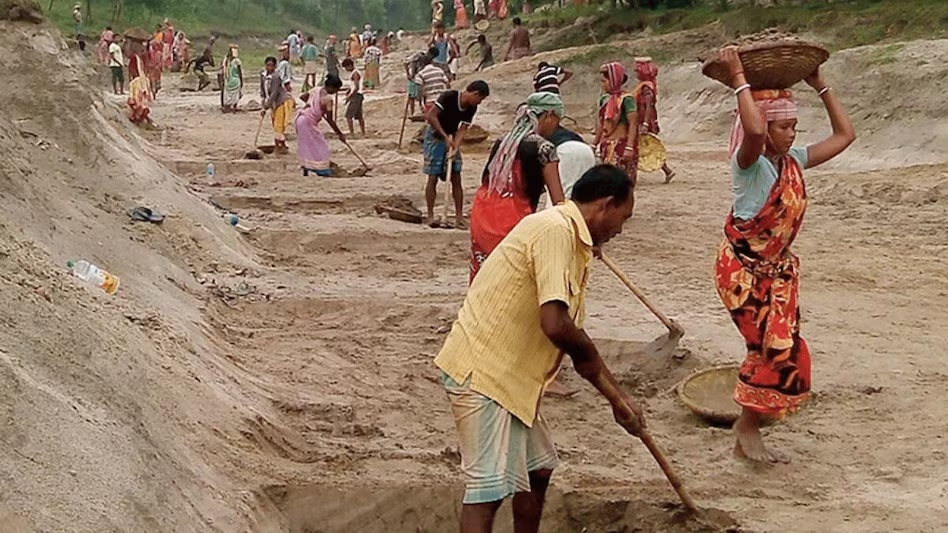





Disclaimer: Copyright infringement is not intended.
Context:
Asur people
|
About |
●They are a very small Austroasiatic ethnic group living primarily in the Indian state of Jharkhand, specifically within the Gumla, Lohardaga, Palamu, and Latehar districts. |
|
Population |
●Asur tribe in Jharkhand has a population of 7,783, which is 0.13% of the state's total population. ●However, the 2011 census recorded a population of around 23,000 in the Latehar and Gumla districts. |
|
Recognition |
●The Asurs were officially recognized as a Scheduled Tribe in 2014. ●They were also recognised as a Particularly Vulnerable Tribal Group (PVTG) in Jharkhand. |
|
Language |
●They speak Asur, a Munda language. |
Occupations |
●They are traditionally iron-smelters. ●They were once hunter gatherers, having also involved in shifting agriculture. ●However, majority of them shifted into agriculture with 91.19 percent enlisted as cultivators in the 2011 census. |
|
Social Life |
●They live in pats (a clearing area) surrounded by the forest, and their houses are made of mud walls supported by wooden poles with a roof covered with paddy straw and self-baked khapras (tiles). ●They have their own community council (jati panch) where disputes are settled. ●They accept food from Rajputs, Oraon, Kharwar, Thakur, Ghasi, and few others; and maintain putative kinship ties with Kharwar, Munda and other neighbouring tribes. ●The Asur religion is a mixture of animism, animatism, naturalism and ancestral worships. |
|
Divisions |
●The modern Asur tribe is divided into three sub-tribal divisions, namely Bir (Kol) Asur, Birjia Asur and Agaria Asur. The Birjia are recognized as a separate schedule tribe. ●They are further divided into 12 clans. ●These Asur clans are named after different animals, birds and food grains. Family is second prominent institution after the clan.
|
|
Challenges |
●Lack of Access to Basic Amenities: Lack of access to proper basic amenities like health services, education, transportation, drinking water, etc. ●Impact of Traditional Occupation Elimination: They are on the verge of becoming destitute because of the elimination of their traditional occupation: iron-smelting. ●Threats to Agricultural-Based Economy: Their agricultural based economy is also in danger due to bauxite mining in the area. ●Migration and Displacement Issues: It has become their major problem. There have been cases of human trafficking of the minor girls, poverty is a big reason behind it. ●Efforts to Preserve Culture and Identity: ○A young Asur woman called Sushma Asur is striving hard to preserve art, culture and the existence of her community. ○According to a 2020 study, only half of the Asur community in Latehar and Gumla districts are fluent in Asur language, and Asur is listed in UNESCO's Interactive Atlas of the World's Languages in Danger. |
To study in detail about the Forest Rights Act, refer the article:
https://www.iasgyan.in/daily-current-affairs/forest-rights-act-5
PVTGs and their status:
https://www.iasgyan.in/daily-current-affairs/pvtgs
Source:
|
PRACTICE QUESTION Q. With reference to “Asur Tribes” recently seen in news, consider the following statements?
How many of the statements above is/are correct? A. only one Answer: A Explanation: Statement a is incorrect: ●They are a very small Austroasiatic ethnic group living primarily in the Indian state of Jharkhand, specifically within the Gumla, Lohardaga, Palamu, and Latehar districts. ●Asur tribe in Jharkhand has a population of 7,783, which is 0.13% of the state's total population. ●However, the 2011 census recorded a population of around 23,000 in the Latehar and Gumla districts. Statement 2 is incorrect: ●They speak Asur, a Munda language. ●According to a 2020 study, only half of the Asur community in Latehar and Gumla districts are fluent in Asur language, and Asur is listed in UNESCO's Interactive Atlas of the World's Languages in Danger. Statement 3 is correct: ●They are traditionally iron-smelters. ●They were once hunter gatherers, having also involved in shifting agriculture. ●However, the majority of them shifted into agriculture with 91.19 percent enlisted as cultivators in the 2011 census. Statement 4 is incorrect: ●The Asurs were officially recognized as a Scheduled Tribe in 2014. ●They were also recognised as a Particularly Vulnerable Tribal Group (PVTG) in Jharkhand. |





© 2025 iasgyan. All right reserved